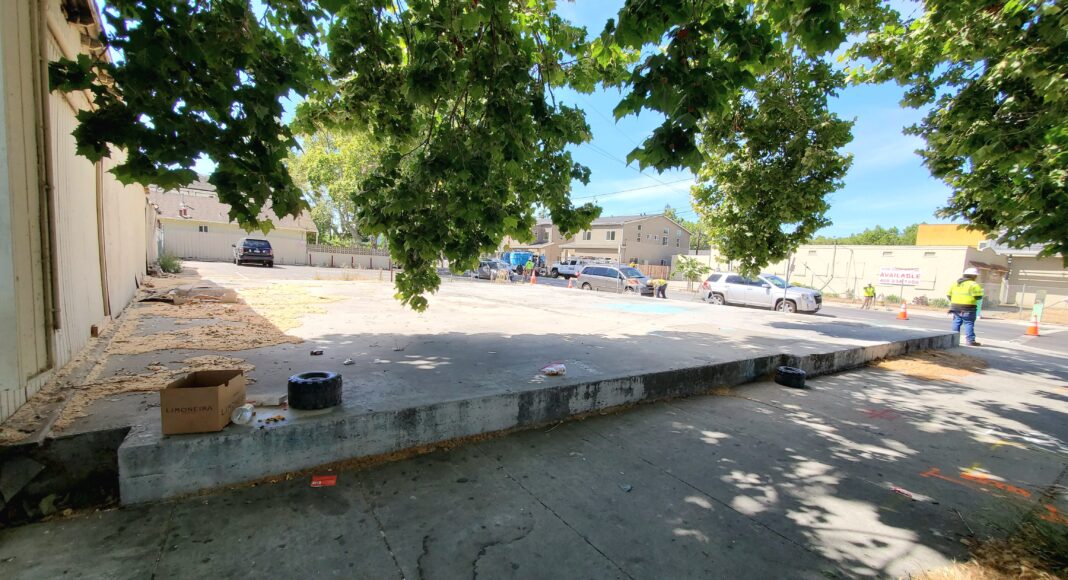The empty concrete slab at 21st and Santa Clara Street is where Jack Kerouac bought wine and cigarettes 70 years ago.
Standing in the shadows, I recently surveyed the poetic scene. This historical tidbit of smokes and booze emerged after I viewed some old photographs taken by Carolyn Cassady, who along with her family lived across the street at 1047 E. Santa Clara in the early ’50s. At the time, she snapped several shots of the building that used to occupy the concrete slab.
Carolyn was married to Neal Cassady, the prime mover behind the Beat-era troublemakers. I have previously written about their Santa Clara Street house several times, which included various exploits with Jack Kerouac and Allen Ginsberg, but at the time of the Cassadys’ life in that house, one contiguous building occupied several addresses across the street. On the corner, at 1000 E. Santa Clara was Jaca’s Liquors, with flats upstairs. The next few addresses, 1002-1008, were part of the same building, owned by the same family for generations. Jaca’s Garage was the business at the other end of the building. In giant letters, “Jaca’s Market” was painted across the front of the whole complex. A vertical sign was also attached to the façade.
One of the photos in question features Carolyn Cassady’s own handwriting describing the structure across the street. It says: “Market where Jack shopped for cigs and wine across from 1047 S. Santa Clara St., S.J., 1953.” This was Kerouac, of course. The man himself.
Pieces of the old Jaca building remain in the current day. The building, or what’s left of it, has been operating as a Vietnamese restaurant, Binh Minh, for well over 20 years. Next door, operating until just recently, was a hair salon, which is now closed because the roof caved in. However, the west end of the building that formerly occupied the corner at 21st Street—the liquor store with the flats upstairs—is long gone, with only the concrete foundation remaining. As recently as the early ’90s, Jaca’s Liquors still existed, although the building was falling apart, its days already numbered. After being fenced off for years, the corner piece was demolished in 2000.
That year provided the final apocalyptic moment, clearly revealed if one rifles through the staggering Kerouacian rollercoaster of permit history for the whole connected building. By 2000, Binh Minh was in business, as was the beauty salon next door, but Jaca’s Liquors on the corner was shabby, beat-up and non-operational, a major hazard to itself and everything nearby. Homeless people were taking over the upstairs. There had also been a fire.
The fateful day came in September of that year when city inspectors found no less than 10 serious violations, including “Abandoned Building or Structure,” “Attractive Nuisance,” “A Building or Structure Which is in a State of Disrepair” and “Property Which Creates a Dangerous Condition.” Other sections of the code declared that such a building “is likely to collapse because of dilapidation, deterioration and decay.”
I’m not saying those words describe Kerouac himself in his final years, but there was something deeply poetic about sifting through the demolition permits. The old wise guys from the East will tell you how the temporal landscape merges with the physical landscape in various spiritual ways, often with ghosts emerging when least expected. That was the case here, as I consumed the permit history, bringing a whole new flavor to the term “disembodied poetics.”
Today, though, the old-school vertical sign attached to the front façade appears to be exactly the same sign that was used 70 years ago when the building housed the Jaca family of businesses. The sign is in a gloriously crumbling state of decay, faded, tarnished, oxidized and with lettering flaking off in every direction. There appears to be a label scar left from a previous restaurant, yet nothing remains from the Jaca days. But it’s the same sign. For sure.
See? There is indeed a literary history of Santa Clara Street. If San Francisco can build an entire industry on the backs of the Beats, then San Jose should too. As I stood in the shadows of the concrete slab, I felt Kerouac would have been proud.



